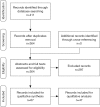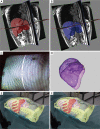High intensity focused ultrasound (HIFU) applied to hepato-bilio-pancreatic and the digestive system-current state of the art and future perspectives
- PMID: 27500145
- PMCID: PMC4960411
- DOI: 10.21037/hbsn.2015.11.03
High intensity focused ultrasound (HIFU) applied to hepato-bilio-pancreatic and the digestive system-current state of the art and future perspectives
Abstract
Background: High intensity focused ultrasound (HIFU) is emerging as a valid minimally-invasive image-guided treatment of malignancies. We aimed to review to current state of the art of HIFU therapy applied to the digestive system and discuss some promising avenues of the technology.
Methods: Pertinent studies were identified through PubMed and Embase search engines using the following keywords, combined in different ways: HIFU, esophagus, stomach, liver, pancreas, gallbladder, colon, rectum, and cancer. Experimental proof of the concept of endoluminal HIFU mucosa/submucosa ablation using a custom-made transducer has been obtained in vivo in the porcine model.
Results: Forty-four studies reported on the clinical use of HIFU to treat liver lesions, while 19 series were found on HIFU treatment of pancreatic cancers and four studies included patients suffering from both liver and pancreatic cancers, reporting on a total of 1,682 and 823 cases for liver and pancreas, respectively. Only very limited comparative prospective studies have been reported.
Conclusions: Digestive system clinical applications of HIFU are limited to pancreatic and liver cancer. It is safe and well tolerated. The exact place in the hepatocellular carcinoma (HCC) management algorithm remains to be defined. HIFU seems to add clear survival advantages over trans arterial chemo embolization (TACE) alone and similar results when compared to radio frequency (RF). For pancreatic cancer, HIFU achieves consistent cancer-related pain relief. Further research is warranted to improve targeting accuracy and efficacy monitoring. Furthermore, additional work is required to transfer this technology on appealing treatments such as endoscopic HIFU-based therapies.
Keywords: High intensity focused ultrasound (HIFU); endoluminal applications of HIFU; liver cancer; miniature HIFU delivery system; mucosa and submucosal ablations using HIFU; pancreatic cancer.
Conflict of interest statement
Figures




Similar articles
-
Novel treatment system using endoscopic ultrasound-guided high-intensity focused ultrasound: A proof-of-concept study.Pancreatology. 2024 Feb;24(1):88-92. doi: 10.1016/j.pan.2023.11.013. Epub 2023 Nov 21. Pancreatology. 2024. PMID: 38036413
-
A meta-analysis of palliative treatment of pancreatic cancer with high intensity focused ultrasound.J Ther Ultrasound. 2017 Apr 1;5:9. doi: 10.1186/s40349-017-0080-4. eCollection 2017. J Ther Ultrasound. 2017. PMID: 28373906 Free PMC article.
-
High-intensity focused ultrasound (HIFU) for pancreatic carcinoma: evaluation of feasibility, reduction of tumour volume and pain intensity.Eur Radiol. 2016 Nov;26(11):4047-4056. doi: 10.1007/s00330-016-4239-0. Epub 2016 Feb 17. Eur Radiol. 2016. PMID: 26886904
-
Is high-intensity focused ultrasound (HIFU) an option for neoadjuvant therapy for borderline resectable pancreatic cancer patients? - a systematic review.Int J Hyperthermia. 2021 Sep;38(2):75-80. doi: 10.1080/02656736.2021.1909150. Int J Hyperthermia. 2021. PMID: 34420446
-
Systematic review of the role of high intensity focused ultrasound (HIFU) in treating malignant lesions of the hepatobiliary system.HPB (Oxford). 2021 Feb;23(2):187-196. doi: 10.1016/j.hpb.2020.06.013. Epub 2020 Aug 20. HPB (Oxford). 2021. PMID: 32830069
Cited by
-
Pancreatic Ductal Adenocarcinoma: Current and Emerging Therapeutic Uses of Focused Ultrasound.Cancers (Basel). 2022 May 24;14(11):2577. doi: 10.3390/cancers14112577. Cancers (Basel). 2022. PMID: 35681557 Free PMC article. Review.
-
Intra-luminal focused ultrasound for augmentation of gastrointestinal drug delivery.Ann Transl Med. 2017 Apr;5(7):178. doi: 10.21037/atm.2017.03.42. Ann Transl Med. 2017. PMID: 28480214 Free PMC article. No abstract available.
-
Pilot in vivo studies on transcutaneous boiling histotripsy in porcine liver and kidney.Sci Rep. 2019 Dec 27;9(1):20176. doi: 10.1038/s41598-019-56658-7. Sci Rep. 2019. PMID: 31882870 Free PMC article.
-
Local Treatments in the Unresectable Patient with Colorectal Cancer Metastasis: A Review from the Point of View of the Medical Oncologist.Cancers (Basel). 2021 Nov 25;13(23):5938. doi: 10.3390/cancers13235938. Cancers (Basel). 2021. PMID: 34885047 Free PMC article. Review.
-
New insights into mechanisms and interventions of locoregional therapies for hepatocellular carcinoma.Chin J Cancer Res. 2024 Apr 30;36(2):167-194. doi: 10.21147/j.issn.1000-9604.2024.02.06. Chin J Cancer Res. 2024. PMID: 38751435 Free PMC article.
References
Publication types
LinkOut - more resources
Full Text Sources
Other Literature Sources
Miscellaneous
